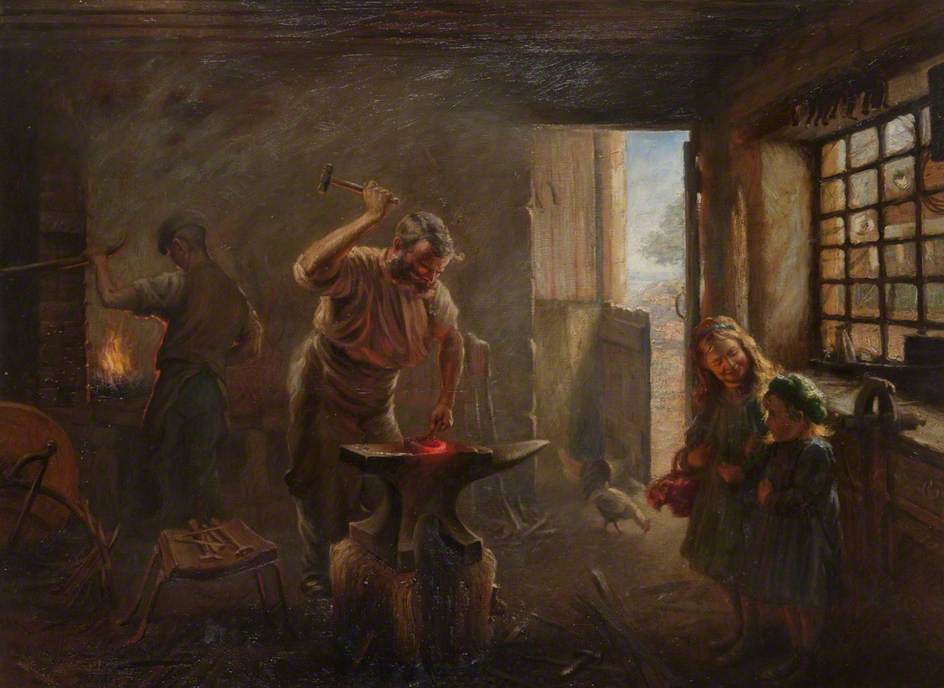|
In a lot of modern stories, iron is fairies' kryptonite. Their silver bullet. All the hero has to do is whip out a cast-iron skillet, and evil sprites cower.
It's often explained as iron having natural anti-magic qualities, or symbolizing the march of industrialization and the fading of magic. Or any other of a billion explanations. For further confusion, it's not just iron. It's "cold" iron. The phrase can be baffling to modern readers, and for maximum confusion there actually is such a thing as cold-wrought iron. However, cold-wrought iron is newer than the phrase "cold iron," which in this case is poetic. "Cold steel" is the modern equivalent and simply means a weapon that to draws blood (Current Literature, 1891). Where did this originate? It's just one of those folkways that can never be sourced to any one person, and always seems to have been "well, everyone knows it." However, you can trace it back through history to an xtent. In Robert Herrick's "Another charme for stables" (1648), the reader is told to hang up metal hooks and shears to protect their horses from being ridden at night by witches. In 1691, Robert Kirk wrote that "The Tramontanes, to this day, put bread, the Bible, or a piece of iron, in womens bed" to prevent newborn children from being stolen by fairies; and "they commonly report, that all uncouth, unknown Wights are terrifyed by nothing earthly so much as by cold Iron." So the phrase and the tradition date back at least to the 1600's. The iron seems to be more popular than the bread as a popular way to repel fairies. I guess it's just not as exciting to send your hero into battle wielding a baguette. The superstition of leaving iron in the bed to prevent fairies kidnapping expectant mothers continued over the centuries. Thus, the way to protect children from being replaced by changelings was usually to leave open scissors, a knife, fire tongs, or a similar object near their cradle. Around 1850, in Northern mythology by Benjamin Thorpe, a story is related where a smith sees a troll kidnapping a pregnant woman. Since the smith is working at his forge, he uses a piece of red-hot iron to frighten off the troll. In other stories in the same volume, trolls and huldra seem to have no trouble with iron. And, like, most people don't want to be chased with red-hot iron. That's not just a magical creature thing. However, there is also a mention of a Danish tradition that "On the eve of Maundy Thursday the country folks cast axes and iron wedges on the sown fields, and fasten steel on all their doors, that the witches may not injure them." In the Ozarks, there were many traditions surrounding iron nails. They could be nailed into someone's footprint - either to hurt an enemy, or a witch. They could be used to prevent disease, or they could be driven into a doorframe, which was particularly effective in protecting (again) pregnant women from evil. These practices were recorded around 1947. So these superstitious practices surrounding iron are surprisingly long-lived. Right into the 20th century! On the other hand, they also go back further than I originally realized. In Natural History, Book XXXIV, Chapter 44, Pliny the Elder mentioned that iron was used both in medicine and in preventative magic. "Iron is employed in medicine for other purposes besides that of making incisions. For if a circle is traced with iron, or a pointed weapon is carried three times round them, it will preserve both infant and adult from all noxious influences: if nails, too, that have been extracted from a tomb, are driven into the threshold of a door, they will prevent night-mare." There is much more about iron and magnets besides this, but this quote alone establishes a history for iron as having magical protective properties. And that was around 79 AD! So at first, it was simply that iron could protect and heal people. Actually, some of the superstitions in Pliny - like iron having healing properties, or the idea of driving nails into a door - were still pretty current in the Ozarks almost 1900 years later. It's easy to see how it could go from "iron protects from evil" to "iron protects from sickness, evil spirits, witches, and fairies" which were all kind of interchangeable at that point. Many of the superstitions center around vulnerable groups, like pregnant women and small infants. A Victorian theory is that the first iron found was from meteorites, which would give it an otherworldly and sacred meaning as something that had fallen from the heavens. However, that's speculation. Iron is a hard and durable metal with the possibility of becoming magnetized. There are beliefs about it and evidence of it being used in amulets and charms for about as long as iron has existed. It was seen as pure or impure by different groups. There were quite a few superstitions surrounding blacksmiths, as well; blacksmiths having healing abilities or, in Scotland, being allowed to perform marriages; and there were gods who were smiths, like the Greek Hephaestus. There are more esoteric explanations, like iron being seen as the lifeforce of the earth, or associated with lifeforce because blood smells like iron. There are superstitions associated with every substance known to humankind. There are some negative superstitions associated with iron, too. This one just happens to be the most well-known. Further Reading
Text copyright © Writing in Margins, All Rights Reserved
1 Comment
MAB
9/22/2018 12:15:23 am
Funny!
Reply
Leave a Reply. |
About
Researching folktales and fairies, with a focus on common tale types. Archives
July 2024
Categories
All
|
Writing in Margins

 RSS Feed
RSS Feed
